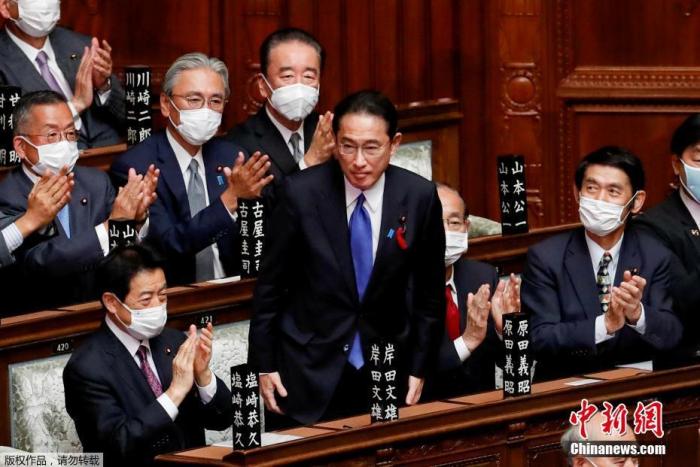China News Service, November 11, reported that on November 10, the current Japanese Prime Minister Fumio Kishida was re-elected as the next prime minister in the Diet. The second Kishida cabinet was subsequently established. Only the Minister of Foreign Affairs changed the new cabinet members.
According to Japanese media analysis, Kishida appointed Lin Fangzheng as foreign minister because he intended to promote Lin Fangzheng, who publicly declared that he "strives to be prime minister," as the "successor of Kishida."
British media said that Kishida's choice of Lin Fangzheng reflects his efforts to strengthen relations with the United States while playing a more confident role in regional security affairs.
On October 4, local time, Fumio Kishida, President of the Japanese Liberal Democratic Party, was elected as the 100th Prime Minister after being named by the Prime Minister in a plenary session of the House of Representatives.
The picture shows Fumio Kishida (middle) standing up to thank him.
The second Kishida Cabinet is launched
The new crown and the economy are still top priorities
Kishida was elected the 100th Prime Minister of Japan on October 4 and dissolved the House of Representatives on October 14.
In the election for the new House of Representatives in Japan on October 31, the ruling coalition’s Liberal Democratic Party and Komeito Party won 293 seats out of the 465 seats in the House of Representatives, allowing them to continue their joint governance.
On the morning of November 10, the entire Japanese Kishida cabinet resigned more than a month ago.
The number of prime ministers in the first Kishida cabinet was 38 days, including the pre-war period, setting a new record for the shortest time in history.
On the afternoon of the 10th, Fumio Kishida was elected as the 101st Prime Minister of Japan in the form of prime minister nomination election in the Diet.
Subsequently, the 2nd Kishida Cabinet was established and started operation.
In the second Kishida cabinet, only the Minister of Foreign Affairs has changed, and the former Minister of Education, Culture, Sports, Science and Technology, who belongs to the Kishida faction of the Liberal Democratic Party, has been the only member of the cabinet.
Along with the work of the second Kishida cabinet, Fumio Kishida said on the evening of the 10th that responding to the new crown epidemic and developing the economy are the current priorities of the Japanese government.
Kishida intends to announce to the people the overall plan for the response to the new crown epidemic on the 12th. On the 19th, the cabinet meeting will finalize the new crown countermeasures and economic countermeasures including the correction of the gap between the rich and the poor, and accelerate the preparation of the 2021 supplementary budget and the 2022 original budget.
The new foreign minister is the prime minister's "successor"?
Kishida intends to strengthen relations with the United States
The Kyodo News Agency of Japan analyzed that Fumio Kishida appointed Lin Fangzheng, the second-in-chief of the Kishida faction of the Liberal Democratic Party and former minister of science and technology, as the foreign minister. He intended to promote Lin Fangzheng, who publicly declared that he "strives to be prime minister," as the "successor of Kishida."
Regarding the appointment of Lin Fangzheng as foreign minister, people close to Kishida revealed that "this is a message to train the prime minister's successor and allow the Hongchikai (Kishida faction) regime to continue for a long time."
According to the analysis, Kishida intends to let him compete with the secretary general Toshimitsu Motegi and others for the position of prime minister to consolidate the political foundation.
The British "Financial Times" pointed out that Fumio Kishida appointed a heavyweight as the Minister of Foreign Affairs.
Analysts said that Kishida Fumio’s choice of Lin Fangzheng reflects his efforts to strengthen relations with the United States while playing a more confident role in regional security affairs.

